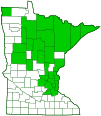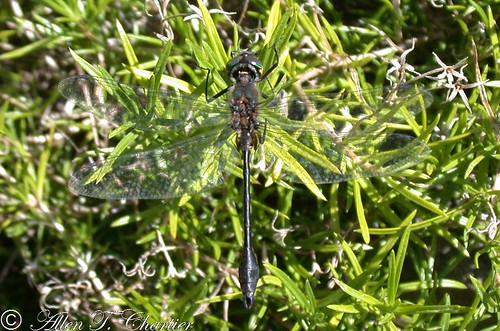racket-tailed emerald
(Dorocordulia libera)
Conservation • Description • Habitat • Ecology • Distribution • Taxonomy
|
|
|||||||||||||
Description |
Racket-tailed emerald is a fairly common, small, slender, 1⅛″ to 1⅝″ long emerald. The thorax is dark brown and metallic green with no vertical stripes on the sides. It is densely covered with brown hairs. The abdomen is long, slender, and black. There are no spots on the upper (dorsal) surface. The base of the abdominal segment 3 has a yellow ring around it that is uneven in width, wider at the base, forming a lower lateral basal spot. On the male, abdominal segments 7 through 9 are greatly expanded and somewhat flattened horizontally, forming a flat club. On the female, segments 7 through 9 are only slightly expanded. The wings are long, slender, and clear except for a black stigma at the leading edge of each wing and sometimes a small amber-tinted patch near the base. The forewing triangle does not have a cross vein. The eyes are bright green and are in contact at the top of the head. The face is metallic green. The legs are black. |
Size |
1⅛″ to 1⅝″ long |
Similar Species |
American emerald (Cordulia shurtleffii) is larger, up to 1⅞″ long. The ring around the base of abdominal segment 3 is narrow and even in width. The forewing triangle has a cross vein. |
Habitat |
Small lakes, ponds, lake coves, and slow streams with boggy edges. |
Ecology |
Season |
Early June to mid-August |
Behavior |
|
Life Cycle |
|
Naiad Food |
|
Adult Food |
|
Distribution |
||
|
Sources Biodiversity occurrence data published by: Minnesota Biodiversity Atlas (accessed through the Minnesota Biodiversity Atlas Portal, bellatlas.umn.edu, 8/2/2025). Haarstad, J. 1997. The dragonflies of selected eastern Minnesota rivers. Report submitted to the Minnesota Department of Natural Resources. Unpaged. Steffens, W. P., and W. A. Smith. 1999. Status survey for special concern and endangered dragonflies of Minnesota: population status, inventory and monitoring recommendations. Final report submitted to the Natural Heritage and Nongame Research Program, Minnesota Department of Natural Resources. 54 pp. |
|
| 8/2/2025 | ||
Occurrence |
||
Fairly common |
||
Taxonomy |
|
Order |
Odonata (Dragonflies and Damselflies) |
Suborder |
|
Superfamily |
Libelluloidea |
Family |
Corduliidae (emerald dragonflies) |
Subfamily |
Corduliinae |
Genus |
Dorocordulia (lesser emerald dragonflies) |
Subordinate Taxa |
|
|
|
Synonyms |
|
Cordulia libera |
|
Common Names |
|
racket-tailed emerald |
|
Glossary
Stigma
In plants, the portion of the female part of the flower that is receptive to pollen. In Odonata and Hymenoptera, a blood-filled blister or dark spot at the leading edge of each wing toward the tip, thought to dampen wing vibrations and signal mates. In Lepidoptera, an area of specialized scent scales on the forewing of some skippers, hairstreaks, and moths.
Visitor Photos |
||
Share your photo of this insect. |
||
This button not working for you? |
||
|
||
|
||
MinnesotaSeasons.com Photos |
||
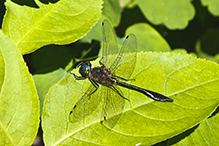 |
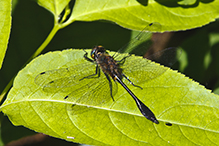 |
|
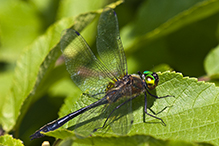 |
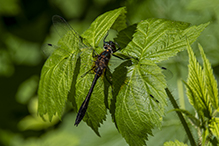 |
|
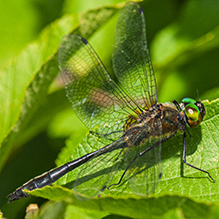 |

Visitor Videos |
||
Share your video of this insect. |
||
This button not working for you? |
||
|
Other Videos |
||
Racket-tailed Emerald Dragonfly (Corduliidae: Dorocordulia libera) on Grass Blade |
About
Uploaded on Jul 2, 2011 Photographed at the Rydell NWR, Minnesota (29 June 2011). |

Visitor Sightings |
||
Report a sighting of this insect. |
||
This button not working for you? |
||
|
|
MinnesotaSeasons.com Sightings |
||

Created: 10/29/2012 Last Updated: © MinnesotaSeasons.com. All rights reserved. |
